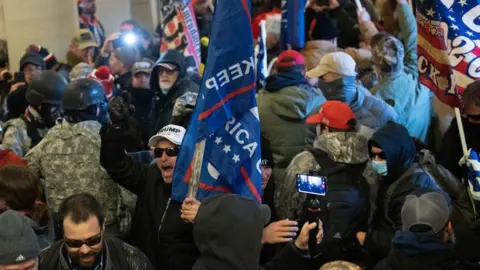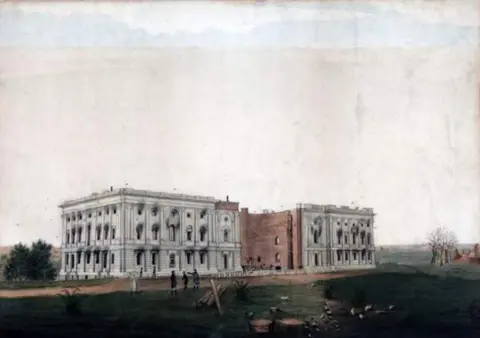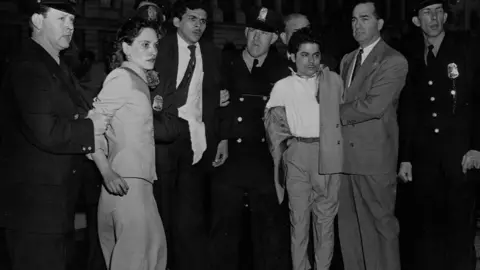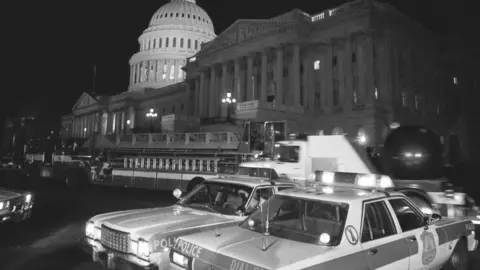Capitol riots: Has the US legislature been attacked before?
 Getty Images
Getty ImagesImages of rioters storming the US Capitol in a bid to overturn the result of a democratic election have sent shockwaves around the world.
Four people died during the attack, launched by supporters of President Trump after he addressed a rally in Washington.
President-elect Joe Biden called it an "insurrection", while Vice-President Mike Pence said the violence had been a "dark day in the history of the United States Capitol".
But this is not the first time the building - regarded as the symbolic heart of US democracy - has been hit by violence.
From bombs to foreign invasions, here are four other times the Capitol was attacked.
British forces try to burn it down - 1814
Perhaps the most famous attack was by British forces during the War of 1812.
British troops, led by Vice Admiral Sir Alexander Cockburn and Major General Robert Ross - set fire to the still-under-construction Capitol after invading Washington DC in August 1814 (though the building survived thanks to a downpour).
 Getty Images
Getty ImagesIn retaliation for the Americans' burning of Upper Canada's capital at York a year earlier, the British troops also set fire to other parts of the city and key buildings, including the White House.
The 1814 attack marks the only time that a foreign power has captured and occupied Washington.
In 2014, the British embassy in Washington apologised after tweeting a picture of a White House cake surrounded by sparklers, "commemorating" the burning of the building 200 years before.
Fourth of July dynamite attack- 1915
A century on from the British attack, Erich Muenter, former professor of German at Harvard University, exploded three sticks of dynamite in the Senate reception room.
The explosion damaged the building, but nobody was killed.
Muenter later said the attack was in response to American financiers aiding Britain against Germany in World War I.
Writing under a pseudonym in the Washington Evening Star, Muenter said he hoped the attack would "make enough noise to be heard above the voices that clamour for war", adding: "This explosion is an exclamation point in my appeal for peace."
A day after the attack, Muenter shot and injured financier JP Morgan Jr, before being subdued by Morgan's butler and arrested. He later took his own life.
Attack by Puerto Rican nationalists - 1954
On 1 March 1954, four Puerto Rican nationalists pulled out the island's flag and shouted "Freedom for Puerto Rico" as they opened fire from the visitors' gallery of the House of Representatives, injuring five congressmen.
"I did not come to kill anyone, I came to die for Puerto Rico!" cried the leader, Lolita Lebron, during her arrest.
 Getty Images
Getty ImagesLebron was sentenced to 50 years behind bars, while the three men were given 75 years.
The sentences were all later commuted by President Jimmy Carter. His administration said the release "would be a significant humanitarian gesture and would be viewed as such by much of the international community".
The group returned to cheering crowds in Puerto Rico.
'Resistance Conspiracy' bomb - 1983
On 7 November 1983, an explosion ripped through the second floor of the Senate.
Just minutes before the explosion, someone claiming to be from a group named the Armed Resistance Unit called a Capitol switchboard warning of a pending attack, saying it was in retaliation for US military actions in Grenada and Lebanon.
 Getty Images
Getty ImagesThere were no casualties but there was some costly damage.
In 1988, FBI agents arrested seven members of the radical-left Resistance Conspiracy group for the Capitol attack and separate blasts at Fort McNair and the Washington Navy Yard in 1983 and 1984.
Linda Evans and Laura Whitehorn were jailed for conspiracy and malicious destruction of government property in 1991. Both are now free.
